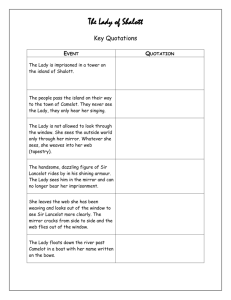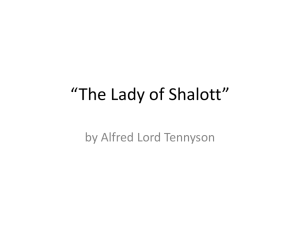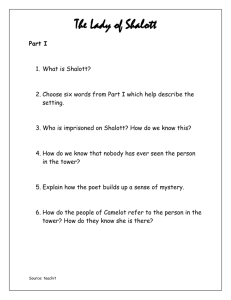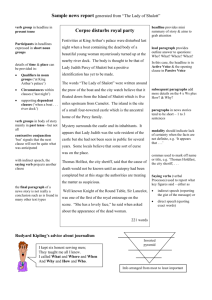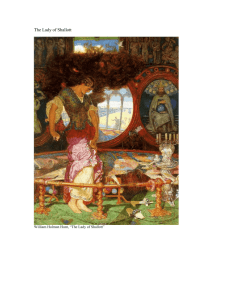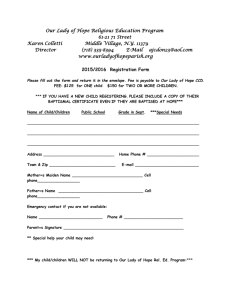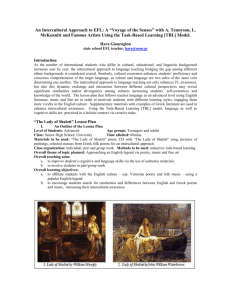The Lady of Shallot - 9th Grade Introduction to British Literature: Poetry
advertisement
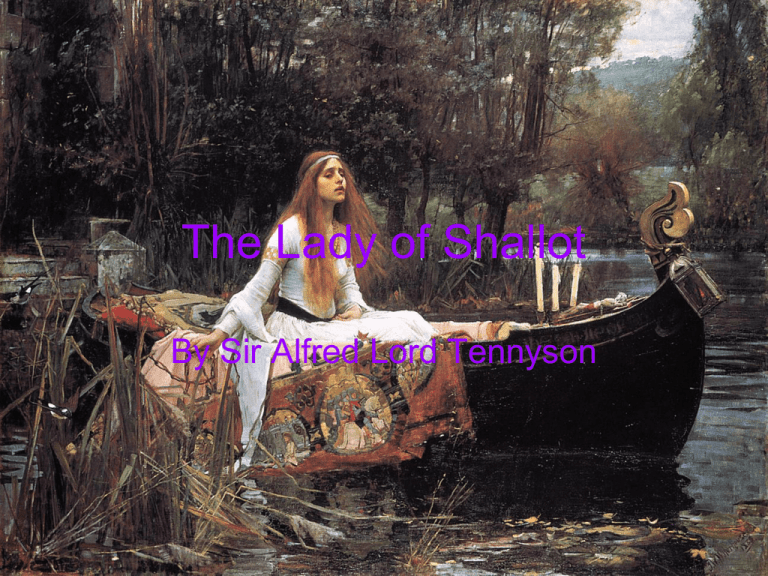
The Lady of Shallot By Sir Alfred Lord Tennyson Sir Alfred Lord Tennyson • • • • 1809-1892 Prominent Victorian Era Poet Published his first work of poetry in 1830 “The Lady of Shallot” appeared in 1842 in the two-volume Poems which established his reputation as a writer. • His most well-known works include “In Memoriam,” “The Charge of the Light Brigade,” “Idylls of the King,” and “Maud.” • He was made a baron in 1884 The Lady of Shallot • • • • • On either side the river lie • Long fields of barley and of rye, That clothe the wold and meet the sky; And thro' the field the road runs by To many-tower'd Camelot; And up and down the people go, Gazing where the lilies blow Round an island there below, The island of Shalott. Willows whiten, aspens quiver, • Little breezes dusk and shiver Through the wave that runs for ever By the island in the river Flowing down to Camelot. Four grey walls, and four grey towers, Overlook a space of flowers, And the silent isle imbowers The Lady of Shalott. By the margin, willow veil'd, • Slide the heavy barges trail'd By slow horses; and unhail'd The shallop flitteth silken-sail'd Skimming down to Camelot: But who hath seen her wave her hand? Or at the casement seen her stand? Or is she known in all the land, The Lady of Shalott? Only reapers, reaping early, • In among the bearded barley Hear a song that echoes cheerly From the river winding clearly; Down to tower'd Camelot; And by the moon the reaper weary, Piling sheaves in uplands airy, Listening, whispers, " 'Tis the fairy Lady of Shalott." There she weaves by night and day • A magic web with colours gay. She has heard a whisper say, A curse is on her if she stay To look down to Camelot. She knows not what the curse may be, And so she weaveth steadily, And little other care hath she, The Lady of Shalott. And moving through a mirror clear • That hangs before her all the year, Shadows of the world appear. There she sees the highway near Winding down to Camelot; There the river eddy whirls, And there the surly village churls, And the red cloaks of market girls Pass onward from Shalott. Sometimes a troop of damsels glad, • An abbot on an ambling pad, Sometimes a curly shepherd lad, Or long-hair'd page in crimson clad Goes by to tower'd Camelot; And sometimes through the mirror blue The knights come riding two and two. She hath no loyal Knight and true, The Lady of Shalott. But in her web she still delights • To weave the mirror's magic sights, For often through the silent nights A funeral, with plumes and lights And music, went to Camelot; Or when the Moon was overhead, Came two young lovers lately wed. "I am half sick of shadows," said The Lady of Shalott. A bow-shot from her bower-eaves, • He rode between the barley sheaves, The sun came dazzling thro' the leaves, And flamed upon the brazen greaves Of bold Sir Lancelot. A red-cross knight for ever kneel'd To a lady in his shield, That sparkled on the yellow field, Beside remote Shalott. The gemmy bridle glitter'd free, • Like to some branch of stars we see Hung in the golden Galaxy. The bridle bells rang merrily As he rode down to Camelot: And from his blazon'd baldric slung A mighty silver bugle hung, And as he rode his armor rung Beside remote Shalott. All in the blue unclouded weather • Thick-jewell'd shone the saddle-leather, The helmet and the helmet-feather Burn'd like one burning flame together, As he rode down to Camelot. As often thro' the purple night, Below the starry clusters bright, Some bearded meteor, burning bright, Moves over still Shalott. His broad clear brow in sunlight glow'd; • On burnish'd hooves his war-horse trode; From underneath his helmet flow'd His coal-black curls as on he rode, As he rode down to Camelot. From the bank and from the river He flashed into the crystal mirror, "Tirra lirra," by the river Sang Sir Lancelot. She left the web, she left the loom, • She made three paces through the room, She saw the water-lily bloom, She saw the helmet and the plume, She look'd down to Camelot. Out flew the web and floated wide; The mirror crack'd from side to side; "The curse is come upon me," cried The Lady of Shalott. In the stormy east-wind straining, • The pale yellow woods were waning, The broad stream in his banks complaining. Heavily the low sky raining Over tower'd Camelot; Down she came and found a boat Beneath a willow left afloat, And around about the prow she wrote The Lady of Shalott. And down the river's dim expanse Like some bold seer in a trance, Seeing all his own mischance -With a glassy countenance Did she look to Camelot. And at the closing of the day She loosed the chain, and down she lay; The broad stream bore her far away, The Lady of Shalott. Lying, robed in snowy white That loosely flew to left and right -The leaves upon her falling light -Thro' the noises of the night, She floated down to Camelot: And as the boat-head wound along The willowy hills and fields among, They heard her singing her last song, The Lady of Shalott. Heard a carol, mournful, holy, Chanted loudly, chanted lowly, Till her blood was frozen slowly, And her eyes were darkened wholly, Turn'd to tower'd Camelot. For ere she reach'd upon the tide The first house by the water-side, Singing in her song she died, The Lady of Shalott. Under tower and balcony, By garden-wall and gallery, A gleaming shape she floated by, Dead-pale between the houses high, Silent into Camelot. Out upon the wharfs they came, Knight and Burgher, Lord and Dame, And around the prow they read her name, The Lady of Shalott. Who is this? And what is here? And in the lighted palace near Died the sound of royal cheer; And they crossed themselves for fear, All the Knights at Camelot; But Lancelot mused a little space He said, "She has a lovely face; God in his mercy lend her grace, The Lady of Shalott." Who is the Lady of Shallot • • • • The Lady of Shalott is a magical being who lives alone on an island upstream from King Arthur's Camelot. Her business is to look at the world outside her castle window in a mirror, and to weave what she sees into a tapestry. She is forbidden by the magic to look at the outside world directly. The farmers who live near her island hear her singing and know who she is, but never see her. The Lady sees ordinary people, loving couples, and knights in pairs reflected in her mirror. One day, she sees the reflection of Sir Lancelot riding alone. Although she knows that it is forbidden, she looks out the window at him. The mirror shatters, the tapestry flies off on the wind, and the Lady feels the power of her curse. An autumn storm suddenly arises. The lady leaves her castle, finds a boat, writes her name on it, gets into the boat, sets it adrift, and sings her death song as she drifts down the river to Camelot. The locals find the boat and the body, realize who she is, and are saddened. Lancelot prays that God will have mercy on her soul. (http://www.pathguy.com/shalott.htm) Why did he write it? • Tennyson likes to write poems about creatures lost in half-life, and/or people taking decisive, heroic action that leads to their doom; the lady of Shallot is all of these things, and she is also related to the heroic legend of King Arthur and Camelot. • In the poem, the lady finally looks out the window because of loneliness and romantic yearnings; Tennyson wrote this poem in his early 20’s and it reflects that he wondered whether he could abstain from love in his life, which was what was expected of a poet in the Victorian Era. Tennyson did not end up marrying until nearly 20 years later. • This poem also reflects Tennyson’s ideas of himself as a repressed individual in order to be an artist, and he shows this in the isolated condition the lady finds herself in in the poem. She can only weave the tapestry as long as she never looks out into the real world; similarly, Tennyson is expressing that he cannot write if he is experiencing the real world. Modern Connections • All of the paintings used as backgrounds in this slideshow are actual depictions of the poem. Agatha Christie wrote a Miss Marple mystery entitled "The Mirror Crack'd From Side to Side", which was based on the poem and was later made into a movie starring Angela Lansbury. Tirra Lirra by the River, by Australian novelist Jessica Anderson, is the story of a modern woman's decision to break out of confinement, is also an adaptation of the poem. Loreena McKinnet has put the song to music. • Click Here to view a video rendition of Loreena McKennit’s song version of Tennyson’s poem Cultural Connections • The Lady of Shallot is based upon the Arthurian Legend of Camelot and the Knights of the Round Table. The tower the lady is confined to in the poem is North of Camelot, and the Knight whom she sees that finally makes her leave her confined life in the tower is Lancelot. • The Legend of King Arthur, the Knights of the Round Table, and Camelot are remembered centuries later and they still inspire in us images of nobility, heroes, and epic quests and adventures. The story of King Arthur, Sir Lancelot, and Lady Guinevere is remembered as perhaps the greatest tale of romance and tragedy in all of European Literature. • Hawaiian Culture is riddled with legends and myths that helped to shape the literature of Hawaii and the Hawaiian people. Because of this, I have chosen to make a connection between Tennyson’s poem and a Hawaiian Legend. Cultural Connections, Cont • The Legend of Kamapua’a and Pele Kamapua’a was born to the Hawaiian Goddess Hina, but she was a young woman and her husband was an aged old man who did not believe that the child was his. As such, he refused to acknowledge his son, and so Kamapua’a grew into a bitter young man, unloved by all around him. He banded together with other young men and together they wreaked havock, until eventually Kamapua’a killed his own father. He sought out his mother, now married to the man his father suspected her of being unfaithful with, but he was denied there as well. From that point on, he forswore any feeling of compassion and lived in the shapeshifted form of a wild hog, or in the form of a human only to seduce women. One day. He encountered a woman so beautiful, it cracked the shell around his heart and so he begged Pele to be his wife. Appalled by his appearance, she refused him and so he swore that if she would not take him willingly, he would take her forcefully. Both were demigods, and so he threatened her with water, and she in return threatened him with fire. In the end, she gave in and they came together, but when he opened up his heart to her, the change in him scared her and so she ran away, giving him a part of the Hawaii Island to cover in the wet lushness that water brings about, while she would cover the other half of the island in the dry fire born of lava. Then Pele ran away and covered her exit in lava so that Kamapua’a could not follow, and the two have never been together since, though both have pined for the other. (http://www.coffeetimes.com/kamapuaa.htm) Cultural Connections, Cont • Though this legend does not have many similarities to the story outlined in the poem “The Lady of Shallot,” both stories are based in legends that have influenced the literature and stories that came after them: King Arthur is a known figure, as are the other characters in his that legend, and any reference of them in later literature is hardly ever expanded upon; similarly, Pele and Kamapua’a are central figures in Hawaiian myths and any story based in Hawaii that contains either of these figures will hardly need any explanation to introduce them • Another reason the Hawaiian Legend and the poem connect is because of the loneliness present in both of these tales. The Hawaiian Legend of Pele and Kamapua’a shows how lonely and isolated Kamapua’a felt because of the stigma of his birth. The Lady of Shallot was also cursed in birth, but by magic instead of by status. Both of these individuals are isolated from other people, and these isolation shaped their entire lives until they each find something that forces them to forsake their imprisonment of loneliness: for the Lady of Shallot, that “something” is Sir lancelot riding by her tower; for Kamapua’a, the “something” is falling in love with Pele. Both figures have unahppy endings: Kamapua’a loses his love and pines for her forever after; the Lady of Shallot dies trying to escape her imprisonment. Websites Used • http://www.coffeetimes.com/kamapuaa.htm • http://www.coffeetimes.com/kamapuaa.htm • http://www.youtube.com/watch?v=QMazwBCa9 yU&feature=related • faeriefae.50megs.com/lady_of_shalott.htm • http://www.lib.rochester.edu/camelot/shalott.htm • http://www.angelfire.com/me2/camelot/shalottAr t6.html

